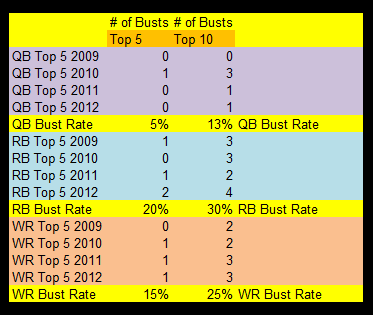
As little Pip learned in the Charles Dickens classic, “Great Expectations,” great expectations can lead to deep disappointment. (Yes, I’m aware I just lost 99% of my audience, but it was worth it.)
Fantasy football is the same thing. If a late round acquisition fails, you've lost very little. But when your highest paid player underperforms, a whole season can be lost.
One key method of bust reduction (no surgery required) is to understand the "Bust Rate" of each position and which positions most frequently perform versus which positions regularly underperform.
But there’s one problem, "The Fantasy Football Bust Rate" information doesn't exist. (As far as my bevy of Google searches could tell.)
Thanks to me, it does now. I just created it. (It took six days, then I rested on Sunday. Coincidence?)
I measured the top ranked preseason players at each position against their actual final outcomes. The results tell us which positions are a safe haven investment, versus the most risky.
As you can see in the chart, quarterbacks are significantly less risky than both running backs and receivers.
In the last four years, only one (one out of 20!) of the preseason Top 5 QBs finished outside the Top 20 in actual QB performance (an injured Tony Romo in 2010). That's really good odds.
What I didn't expect to find, was that receivers were also somewhat less risky than running backs.
A full 25% of Top 10 preseason receivers finished outside the final Top 20. The same can be said for nearly a third of running backs. (Nearly one third of preseason Top 10 RBs end up nearly worthless!)
We all know injuries play a major role in our fantasy football seasons. The Bust Rate is really little more than the injury rate of each position. Top QBs rarely get hurt whereas RB is a brutal, unforgiving position, kind of like some of your wives/husbands. (Only joking).
Notes About Data
Bust is defined as a player who didn't finish in the Top 20 of that year's positional rankings by total FF points.
I used Yahoo's Experts composite preseason ranks, either the last week of August or first week of September, whichever was most readily available.
This represents a small sample size (4 years) because it's difficult getting preseason ranks moving back in time. I wanted to make sure I used a uniform preseason authority (Yahoo! Experts) so as not to be accused of cherry picking numbers.



